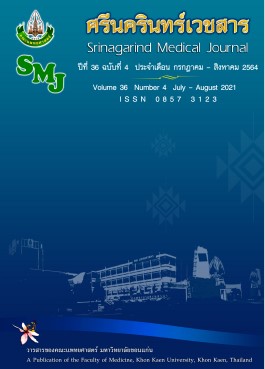เทตระไฮโดรเคอร์คูมิน ลดระดับน้ำตาลในเลือดสูงในหนูที่เป็นเบาหวานผ่านการลดความต้านทานต่ออินซูลินและความเครียดออกซิเดชัน
คำสำคัญ:
เทตระไฮโดรเคอร์คูมิน; น้ำตาลในเลือดสูง; หนูที่เป็นเบาหวาน; ความต้านทานต่ออินซูลิน; ความเครียดออกซิเดชันบทคัดย่อ
หลักการและวัตุประสงค์: โรคเบาหวานเป็นปัญหาสาธารณสุขที่สำคัญระดับโลก โดยมีสาเหตุเกิดจากความผิดปกติของการหลั่งและการออกฤทธิ์ของอินซูลิน โรคเบาหวานก่อให้เกิดภาวะแทรกซ้อนอันเป็นสาเหตุนำไปสู่การเสียชีวิตในผู้ป่วยเบาหวาน การศึกษานี้มีวัตถุประสงค์เพื่อประเมินผลของสารเทตระไฮโดรเคอร์คูมิน (tetrahydrocurcumin, THU) ซึ่งเป็นสารต้านอนุมูลอิสระที่มีฤทธิ์รุนแรง ต่อระดับน้ำตาลในเลือด ระดับอินซูลิน ความต้านทานต่ออินซูลิน และความเครียดออกซิเดชันในหนูที่เป็นเบาหวานด้วย streptozotocin-nicotinamide (STZ-NA)
วิธีการ: หนูสายพันธุ์วิสตาร์เพศผู้ จำนวนสี่สิบตัวได้รับการสุ่มแบ่งออกเป็น 5 กลุ่ม ได้แก่ 1) กลุ่มควบคุม 2) กลุ่มควบคุมควบคุมที่รักษาด้วย THU (100 มก./กก./วัน) 3) กลุ่มเบาหวาน 4) กลุ่มเบาหวานที่รักษาด้วย THU (50 มก./กก./วัน) และ 5) กลุ่มเบาหวานที่รักษาด้วย THU (100 มก. /กก. /วัน) หนูถูกเหนี่ยวให้เกิดโรคเบาหวานด้วยการฉีด STZ ขนาด 55 มก./กก./วัน หลังจากได้รับ NA ขนาด 110 มก. /กก./วัน หลังจากนั้น THU จะถูกป้อนเวลาแปดสัปดาห์ เมื่อครบกำหนด ระดับกลูโคสในพลาสมา ระดับอินซูลิน ความไวต่อการตอบสนองของอินซูลินและตัวชี้วัดความเครียดออกซิเดชันได้แก่มาลอนไดอัลดีไฮด์และโปรตีนคาร์บอนิลในสพลาสมา รวมถึงสารต้านอนุมูลอิสระกลูตาไธโอนได้รับการประเมิน
ผลการศึกษา: หนูที่เป็นโรคเบาหวานมีภาวะน้ำตาลในเลือดสูงร่วมกับภาวะความต้านทานต่ออินซูลินและพบความบกพร่องในการควบคุมน้ำตาลกลูโคส (p<0.05 เมื่อเทียบกับหนูที่ไม่เป็นเบาหวาน) การเปลี่ยนแปลงเหล่านี้พบร่วมกับการเพิ่มขึ้นของภาวะความเครียดออกซิเดชันเนื่องจากพบหลักฐานการเพิ่มขึ้นของ มาลอนไดอัลดีไฮด์และโปรตีนคาร์บอนิลในพลาสมา (p<0.05) นอกจากนี้ยังพบการลดลงอย่างมีนัยสำคัญของสารต้านอนุมูลอิสระกลูตาไธโอนภายในเซลล์ของหนูเบาหวาน การรักษาด้วย THU พบว่าสามารถลดระดับระดับน้ำตาลในเลือดขณะอดอาหาร ช่วยเพิ่มความไวต่อการตอบสนองของอินซูลินและบรรเทาความเครียดออกซิเดชันในหนูที่เป็นเบาหวาน
สรุป: THU สามารถลดระดับน้ำตาลในเลือดในหนูที่ทีภาวะเบาหวาน โดยกลไกของ THU อาจเกี่ยวข้องกับฤทธิ์ลดระดับน้ำตาลโดยการเพิ่มความไวต่อการตอบสนองของอินซูลินและฤทธิ์ต้านอนุมูลอิสระของ THU
เอกสารอ้างอิง
2. Olawale F, I IA, U IA, Nwozo SO. Long-term hyperglycemia impairs hormonal balance and induces oxidative damage in ovaries of streptozotocin-induced diabetic wistar rat. Niger J Physiol Sci 2020; 35: 46-51.
3. Saeed S, Waje-Andreassen U, Nilsson PM. The association of the metabolic syndrome with target organ damage: focus on the heart, brain, and central arteries. Expert Rev Cardiovasc Ther 2020; 18: 601-614.
4. Luc K, Schramm-Luc A, Guzik TJ, Mikolajczyk TP. Oxidative stress and inflammatory markers in prediabetes and diabetes. J Physiol Pharmacol 2019; 70: 809-824.
5. Newsholme P, Keane KN, Carlessi R, Cruzat V. Oxidative stress pathways in pancreatic beta-cells and insulin-sensitive cells and tissues: importance to cell metabolism, function, and dysfunction. Am J Physiol Cell Physiol 2019; 317: C420-C433.
6. Shen CY, Jiang JG, Yang L, Wang DW, Zhu W. Anti-ageing active ingredients from herbs and nutraceuticals used in traditional Chinese medicine: pharmacological mechanisms and implications for drug discovery. Br J Pharmacol 2017; 174: 1395-1425.
7. Pari L, Murugan P. Tetrahydrocurcumin: effect on chloroquine-mediated oxidative damage in rat kidney. Basic Clin Pharmacol Toxicol 2006; 99: 329-334.
8. Sangartit W, Pakdeechote P, Kukongviriyapan V, Donpunha W, Shibahara S, Kukongviriyapan U. Tetrahydrocurcumin in combination with deferiprone attenuates hypertension, vascular dysfunction, baroreflex dysfunction, and oxidative stress in iron-overloaded mice. Vascul Pharmacol 2016; 87: 199-208.
9. Murugan P, Pari L, Rao CA. Effect of tetrahydrocurcumin on insulin receptor status in type 2 diabetic rats: studies on insulin binding to erythrocytes. J Biosci 2008; 33: 63-72.
10. Nakmareong S, Kukongviriyapan U, Pakdeechote P, Kukongviriyapan V, Kongyingyoes B, Donpunha W, et al. Tetrahydrocurcumin alleviates hypertension, aortic stiffening, and oxidative stress in rats with nitric oxide deficiency. Hypertens Res 2012; 35: 418-425.
11. Yadav RK, Rawat JK, Gautam S, Singh M, Kumar M, Ansari MN, et al. Antidiabetic activity of mefloquine via GLP-1 receptor modulation against STZ-NA-induced diabetes in albino wistar rats. 3 Biotech 2018; 8: 240-248.
12. Klisic J, Nief V, Reyes L, Ambuhl PM. Acute and chronic regulation of the renal Na/H+ exchanger NHE3 in rats with STZ-induced diabetes mellitus. Nephron Physiol 2006; 102: 27-35.
13. Tietze F. Enzymic method for quantitative determination of nanogram amounts of total and oxidized glutathione: applications to mammalian blood and other tissues. Anal Biochem 1969; 27: 502-522.
14. Szkudelski T. Streptozotocin-nicotinamide-induced diabetes in the rat. Characteristics of the experimental model. Exp Biol Med (Maywood) 2012; 237: 481-490.
15. Hua ZG, Xiong LJ, Yan C, Wei DH, YingPai Z, Qing ZY, et al. Glucose and insulin stimulate lipogenesis in porcine adipocytes: dissimilar and identical regulation pathway for key transcription factors. Mol Cells 2016; 39: 797-806.
16. Hatting M, Tavares CDJ, Sharabi K, Rines AK, Puigserver P. Insulin regulation of gluconeogenesis. Ann N Y Acad Sci 2018; 1411: 21-35.
17. Lo CC, Lin SH, Chang JS, Chien YW. Effects of melatonin on glucose homeostasis, antioxidant ability, and adipokine secretion in ICR mice with NA/STZ-induced hyperglycemia. Nutrients 2017; 9: 1178-1191.
18. Pari L, Murugan P. Effect of tetrahydrocurcumin on blood glucose, plasma insulin and hepatic key enzymes in streptozotocin induced diabetic rats. J Basic Clin Physiol Pharmacol 2005; 16: 257-274.
19. Chen JW, Kong ZL, Tsai ML, Lo CY, Ho CT, Lai CS. Tetrahydrocurcumin ameliorates free fatty acid-induced hepatic steatosis and improves insulin resistance in HepG2 cells. J Food Drug Anal 2018; 26: 1075-1085.
20. Yaribeygi H, Sathyapalan T, Atkin SL, Sahebkar A. Molecular mechanisms linking oxidative stress and diabetes mellitus. Oxid Med Cell Longev 2020; 2020: 8609213-8609226.




